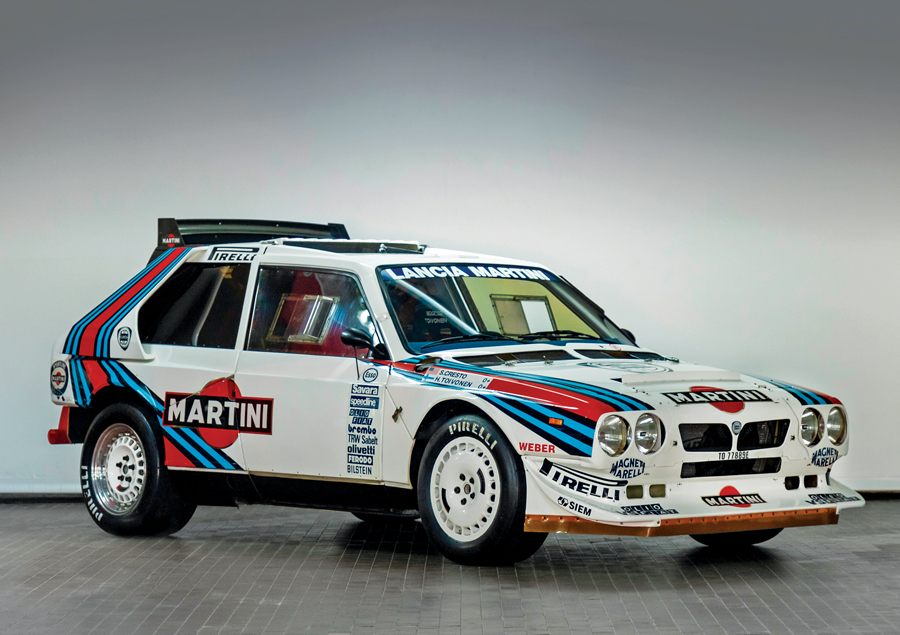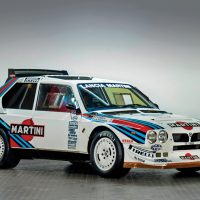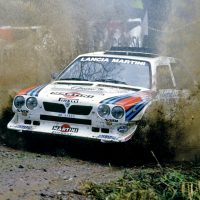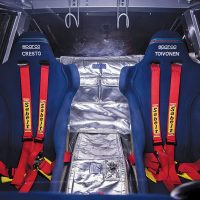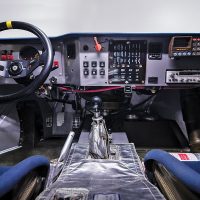SCM Analysis
Detailing
| Vehicle: | 1985 Lancia Delta S4 Rally |
| Years Produced: | 1985–86 |
| Number Produced: | 28 |
| Original List Price: | N/A (Stradales were $56,000) |
| SCM Valuation: | $850,500 (this car) |
| Club Info: | American Lancia Club |
| Website: | http://www.americanlanciaclub.com |
| Alternatives: | 1986 Ford RS 200, 1985 Peugeot 205 Turbo 16 E2, 1985 Audi Quattro E2 |
| Investment Grade: | B |
This car, Lot 152, sold for $985,765, including buyer’s premium, at RM Sotheby’s Olympia, London, U.K., auction on October 24, 2019.
Since the beginning, automobile-racing sanctioning bodies and promoters struggled to balance spectacle and spectator attraction with safety concerns in a sport that was, certainly for the first century of its existence, frequently a blood sport. Rules would be set, only to have technology and ingenuity overwhelm them in the search for ways to go faster and finish first.
Rallying was a relatively genteel and safe corner of the sport until sometime in the 1970s, when promoters figured out the spectator appeal of flat-out racing on closed (normally remote, twisting and gravel) public roads — and manufacturers discovered the halo effect of winning with ostensibly production cars. Professional rallying became a major component of the international competition world, and the FIA, as the governing body, was eager to help.
Hello, Killer Bs
Through the late 1970s and into the early 1980s, rallying was done in production cars with a minimum of 400 cars built, either in Group 2 (4 seats) or Group 4 (2 seats). Four-wheel drive was allowed starting in 1979 on the assumption that the increased weight and complexity would offset the 4WD advantages.
In the interests of spicing things up, the FIA for 1982 introduced a revised set of rules, now with Groups A and B. Group A was pretty much the old Groups 1 and 2, but Group B broke new ground.
Group B was much less restrictive — minimum production was only 200, exotic materials and lower weights were allowed, and forced-induction boost levels were not restricted, allowing far higher horsepower.
More importantly, the rules allowed each manufacturer to build and race 20 “Evolution” variants per year that had to share little with the “production” models beyond basic design layout and appearance. The major manufacturers immediately realized that this meant that they could build 200 “homologation specials” that could be sold, then build 20 pure racing cars per season that looked mostly like the street ones but were insanely faster.
This was the origin of the “Killer B” rally cars.
Different displacement cars were given different weight limits, and forced induction (either supercharged or turbocharged) had an equivalence factor of 1.4. Most everyone chose 2,500-cc engines (1,750 cc with charging), which allowed 860 kg (1,960 lbs) weight — a perfect fit for their small sedan production models.
The Lancia S4
Lancia, the rally racing component of the Fiat empire, initially chose to enter Group B with the “037” (derived from Abarth’s project code), a somewhat larger mid-engine 2WD loosely based on the Lancia Scorpion model. They were successful with it, winning the 1983 Manufacturers’ Championship.
By 1984, though, the writing was on the wall: The future was 4WD — and a smaller car. Lancia’s small hatchback at the time was the Delta, a rather pretty FWD sedan, and it became the nominal base for the 1985 Delta S4.
The new S4, in keeping with Group B tradition, shared nothing with the Delta except the silhouette — if you squinted a bit. This rally car was a tube-frame, mid-engine, all-wheel-drive, fiberglass-bodied, “twincharged” 1,750-cc, 250-horsepower death wish on wheels — and that was the homologation “Stradale” version, which Savio built in Turin.
The “Evolutione” competition cars were built at Abarth from the ground up — and shared little with the Stradale beyond basic architecture.
The bodywork was all carbon fiber, with the fronts and rears removable as units for service or replacement. The car had more suspension travel, bigger shocks, and everything strengthened for brutal usage. And yes, lots more horsepower.
If you want to make huge horsepower with a turbo, it needs to be big, which means it doesn’t work at low speeds. Twincharging means using a supercharger for low speeds and then switching to a turbo above about 4,500 rpm, which made the best use of both. In the comp cars this allowed for anywhere from 500 horsepower to well over 800 horses.
Remember, this is a 2,000-pound car.
Too crazy and dangerous to last
The resulting car and driving experience were insane! Yes, they were horribly dangerous, and yes, they crashed and broke a lot.
During rallies, each car had a van filled with spare body sections, several engines and transmissions, complete suspension corners and so on. Why? So the car could effectively be remade overnight.
This car was a pure weapon, and anyone who speaks of “matching numbers” is blowing smoke. Even complete chassis were frequently replaced.
This level of insanity couldn’t last — and didn’t. 1985 was wild, but 1986 endured a series of horrible accidents that killed both participants and spectators, with the result that the “Killer B” category was abruptly suspended at the end of 1986. They were simply too dangerous.
These beasts still race
The market for these cars is as unique as the cars themselves.
Ferrari and Italian supercar guru Mike Sheehan was a fountain of information for me on this profile. Sheehan knows rally Lancias, the market for them, and this particular car intimately. He has several insights. The first is that the market is almost strictly European, mostly Italian with a few Germans and Brits.
Sheehan says the American collectors “could share a pizza.”
The next is that the owners actually use them, and hard!
These are not static dust catchers. They are driven at or near their limit in frequent events around southern Europe, with one result being an active network of people to service and repair them and another being that not one of the cars has a pristine provenance.
They are purchased and used as exciting toys, not as collectibles. Sure, historical bragging rights are important and have value, but nothing like, say, a racing Ferrari.
As a result, values for “Killer B” rally cars are a strange combination of mostly weapons-grade considerations (how much fun will it be, can I win in one?) and a varying amount of collector ones.
Lancias, being Italian, exotic and highly successful, carry the greatest market value, but even these peaked around $1.2 million about five years ago. Interestingly, the street versions of all “Killer Bs” frequently have more market value than the comp cars: They are more original, nowhere near as beat up, and can be used on the street.
A bit over two years ago, Mike Sheehan was dispatched to Italy with instructions to inspect this car, and if possible, purchase it for €1 million (about $1,150,000 at the time).
Unfortunately, the seller proved uncooperative and the deal fell through, with the apparent result that it failed to sell until now, when it went at auction for $985,765.
There is a clear lesson here for sellers — pride in a soft market is bad strategy. On the assumption that this car was purchased knowledgeably by someone who wants to use it as a joyous (possibly terrifying, certainly exhilarating) experience, it was fairly bought. ♦
